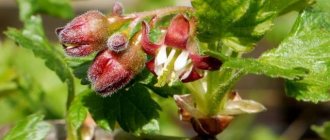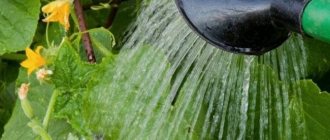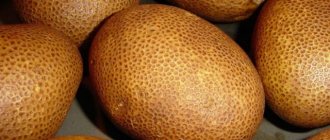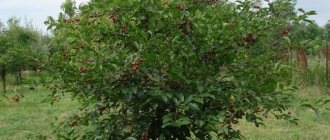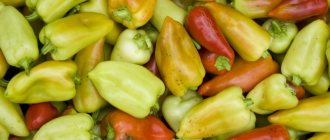Candy gooseberry - this variety of gooseberry is new and has a high level of resistance to drought, cold and adverse weather conditions. The Candy gooseberry variety was officially registered in two thousand and eight. With proper care, this shrub can produce about six kilograms of fruit annually. It is recommended to grow the Candy gooseberry variety in Western and Eastern Siberia.
Candy gooseberry: photo of variety
Immediately before purchasing this shrub for further cultivation on your dacha, suburban or personal plot, you need to find out its characteristics. The gooseberry variety shrub Candy belongs to the group of plants with ordinary growth; the shoots grow straight and dense. Brown buds form on the branches. It is impossible to say that the shrub does not have thorns, because a small number of thorns are located at the base of the plant.
Characteristics, description
The candy tree has a not too voluminous bush and straight, vertically directed branches. Thanks to this structure, the fruit bush can be grown without additional support or garter. The bush is covered with grey-brown smooth bark; on old branches the covering may become fragmented and rough.
The leaves are small, green, without gloss. The peculiarity of Candy is that the variety has thorns only in the lower part of the bush, where berries are not formed. This makes the plant convenient for harvesting and seasonal care.
Video: Gooseberry Jubilee
Selecting a location
Gooseberry is a light-loving plant. In dark places, the growth and development of gooseberries deteriorate significantly, the fruits become smaller, and their number also decreases.
In well-lit areas, Yubileiny bushes will produce a good harvest with large berries.
Jubilee gooseberry, like other varieties of this crop, does not like too wet soil. Such soil and high humidity contribute to rotting of the roots, as a result of which the plant dies.
The following places are unacceptable for gooseberries:
- wetland;
- area with nearby groundwater;
- place with clay soil.
Important! In partial shade, gooseberries will also produce a harvest, but not as abundant as in a well-lit area. Although you can plant several bushes in partial shade, so that after the main crop is harvested from the bushes on the sunny side, you can enjoy the berries from the shaded bushes.
Planting and care, pollination
Planting gooseberries of this variety is carried out according to standard principles for all varieties of this crop. Summer residents and gardeners prefer autumn planting, since in the spring they need to choose a certain period - not before the soil thaws and before the buds swell. If you do not reach this spring deadline, the survival rate of the plant will significantly deteriorate. In the fall, it is necessary to plant the crop 1.5–2 months before the onset of frost, then the plant will have time to take root well.
The optimal distance when planting bushes is 1 m for small and medium bushes, 2 m for large specimens. The depth and dimensions of the planting hole are prepared in accordance with the size of the plant. A pit measuring 0.5x0.5 m is ideal for 1–2-year-old seedlings.
Feeding of shrubs during planting is carried out with the following fertilizers:
- 10 kg of manure or fallen leaves;
- 100 g wood ash;
- 50 g double superphosphate;
- 40 g of potassium sulphide.
Find out when gooseberries begin to bear fruit after planting the seedlings.
All dry roots and upper parts of branches need to be cut off, and 5–7 buds should be left on the shoots. It is advisable to install the bush at a slight slope, cover it with soil and compact it so that there are no voids. The planting process ends with thorough watering.
Feeding the plant takes place in two stages. The first is after the bush blooms, the second is after the harvest.
Gooseberries are a self-pollinating crop, which means that even one bush will bear fruit. However, for high yields, it is recommended to plant several varieties of gooseberries nearby for cross-pollination. The pollinating insects of this crop are bees, wasps, flies, and bumblebees.
Disease and pest control
Jubilee gooseberry is considered relatively resistant to various diseases, primarily to American powdery mildew.
Important! To prevent gooseberry diseases in early April, it is necessary to treat the bushes with boiling water using a watering can and sprayer.
If gray spots are found on the leaves and shoots of the Jubilee gooseberry, this indicates the presence of powdery mildew. At the first signs of the disease, it is necessary to treat the plantings with a soda solution (5 g of baking soda per 1 liter of water) or a solution consisting of 3 g of iron sulfate diluted in 1 liter of water.
Pruning and shaping the bush
The formation of a shrub begins from the first years of plant growth. At this time, a significant part of the root shoots is cut off, and the main perennial branches of the plant are shortened by half.
After the third year, pruning is carried out aimed at eliminating thickening. In this case, all unnecessary, weak, dry shoots are removed. Old shoots are also pruned, because a large percentage of the harvest is on branches that are 3–6 years old.
Wintering
Jubilee gooseberry tolerates wintering well, but in severe frosts the shoots may freeze.
It is necessary to prepare shrubs for winter according to the following rules:
- treat the bushes with special pest repellents;
- dispose of fallen leaves and weeds;
- dig up the soil under the bushes;
- fertilize;
- water generously.
In winter, shrubs should be covered with snow. During winters with little snow, covering the bush with a special covering material would be an excellent option.
Advantages and disadvantages
Growing Candy gooseberries has many advantages, such as: excellent taste, abundant annual harvest, absence of thorns on the branches, and the ability to grow without a garter.
The main disadvantages inherent in the variety include the tendency to be affected by powdery mildew. A gardener can successfully combat this disease by using fungicides and anti-aging pruning of the bush.
Drought resistance, frost resistance
This gooseberry variety has good frost resistance and is grown without shelter in almost any climate. Also, the bush can withstand long-term droughts without damage to the roots and above-ground parts. But the gardener needs to keep in mind that the lack of moisture negatively affects the formation and quality of the crop.
Productivity and fruiting
The round-oval, slightly pubescent berries of Candy are large and medium in size (3–6 g). When unripe, the fruits are colored green; gradually, as they ripen, the berries acquire a dark pink color. The taste of the fruit is very sweet, which is reflected in the name of the variety.
Did you know? The result of crossing varietal currants and sweet gooseberries is a shrub called yoshta. From the first parent the hybrid took the black color of the berry and the absence of thorns on the branches; from the second ancestor it received the size and shape of the berry.
The bush is productive, depending on the age of the gooseberry and growing conditions, you can get from 2 to 6 kg of berries from one plant. When grown in southern regions, Candy fruits begin to ripen by the end of July; in colder climates, harvesting takes place in August.
What kind of gooseberry is this?
Candy is an unpretentious and frost-resistant delicacy variety that, if you follow the care instructions, gives an excellent harvest. It belongs to the mid-season, although some gardeners classify it as a late crop. Ripening times may vary depending on the weather and region.
Brief history of origin and distribution
The variety was obtained at the South Ural Research Institute of Horticulture and Vegetable Growing by a breeder from Yekaterinburg, V. S. Ilin. In 2008, the Confetny variety was registered in the State Register of the Russian Federation. This gooseberry is intended for cultivation in Western and Eastern Siberia.
Landing
If the plant is planted correctly, the berry harvest will be abundant and fruiting will be annual. In this case, it is necessary to take into account such important parameters as the location of the bush, healthy seedling material, and compliance with the planting scheme.
Deadlines
Gooseberries can be planted in spring and autumn, but autumn planting is optimal, the date of which can be chosen arbitrarily, from the second half of October to early November. Planting at this time gives the plant a better chance of adaptation and root regeneration.
Also in autumn, the soil is quite moist and there is no heat, and such weather is favorable for transplanting and rooting of shrubs. Bushes planted in autumn have sufficient growth vigor.
Spring planting should be carried out as early as possible, before the plants enter the growing season (before buds open). To perform this activity, you should choose cool and cloudy days.
Also find out what can be planted next to gooseberries and the features of the neighborhood.
Choosing a suitable location
Gooseberries usually bear fruit for 10–15 years. To establish a plantation, choose flat or slightly raised areas of soil. It is undesirable to grow the crop in valleys where cold air accumulates; in this case, the bushes are easily exposed to frost.
The depth of the groundwater level at the planting site should be from 70 to 100 cm. The crop does not require particularly fertile soil; the plant grows well on clay and sandy substrates with a pH of 6.2–6.7.
An important condition that you should pay attention to when planning to grow gooseberries is the direction of the prevailing winds. Too much wind can cause the fruit to drop prematurely or the plant to freeze. For proper growth and development, the shrub requires full and regular watering.
Read more
Soil acidity for planting gooseberries After choosing a place for planting, it is time to prepare the land for cultivation. If the soil is too acidic or alkaline, it is necessary to liming and bring the pH to the desired value (6.2–6.7).
The area should also be cleared of weeds, which is facilitated by pre-planting root crops or pumpkin plants. Cultivation of these crops will lead not only to clearing the beds of weeds, but also to loosening the soil.
Pre-treatment of the soil begins two months before the planned planting.
The optimal time for planting is October and March , so it is important to carry out this treatment in August or January, respectively. The most convenient time for planting is the autumn season, since in January the soil in the garden is usually frozen.
To fertilize the soil, you need to dig a small hole in the ground about half a meter wide and deep and the desired length (depending on the number of bushes for future planting with a distance between them of 1 to 1.5 m).
Organic matter, potash fertilizers and fertile soil are placed in the recess. The soil enriched with nutrients is left in a loose state, without compaction.
Selection and preparation of planting material
To plant Candy gooseberries, it is advisable to purchase young bushes from a qualified berry nursery. It is worth ordering planting material approximately two years before the start of planting the berry garden. Annual or biennial shrubs are usually planted.
It is recommended to choose plants with a developed root system and 2-3 above-ground shoots. After purchasing a bush, during the entire transportation time, the roots of the plant should be wrapped in damp cloth to prevent them from drying out.
Important! If, after purchasing a seedling, you need to wait a few days before planting, it is advisable to temporarily sprinkle the gooseberry root system with moist soil.
Planting scheme
In a previously fertilized area, planting holes are dug, which, if several shrubs are planted, should be spaced apart from each other by approximately 1–1.5 m. If several rows of plants are laid side by side, the distance between them should be at least 1.5 m. The interval depends on the method of cultivation and harvesting.
On large industrial plantations, where mechanical harvesting of fruits is usually carried out, the following distance between plants is assumed:
- on poor soils 3.5 m (between rows) × 0.5–0.6 (in a row);
- on fertile soils 4.0 m (between rows) × 0.5–0.6 m (in a row).
For his own use, it is enough for a gardener to have 5–6 gooseberry bushes on his plot. Planting holes should have a depth and width no less than the depth and width of the root of a particular bush, with an additional gap of about 10 cm for further development of the root system.
The shrub is planted to a depth 5 cm greater than it grew in the nursery. Before placing the seedlings in the hole, all damaged or diseased roots are cut off, and after planting, a cut is made of the above-ground part - above the first eye, counting from the surface of the earth.
The most common arrangement of gooseberry rows is from north to south. If the site for planting shrubs is well protected from the wind, you can choose the east-west direction.
Find out in more detail what distance is recommended to be kept between the bushes and rows of gooseberries.
Pest and disease control
The main diseases to which gooseberries are susceptible are given in the table:
| Disease | Symptoms | Control measures | Prevention |
| Powdery mildew | A loose whitish coating appears on the shoots. Gradually, the coating darkens and covers the leaves, branches and fruits. | All affected parts are cut off and burned. Gooseberries are treated with Bordeaux mixture, solutions of Topaz or Fundazol. |
|
| Anthracnose | White spots appear on the leaves, which grow and change color to brown. In later stages, the leaves dry out and fall off. | Treatment of gooseberries with Bordeaux mixture. |
|
| Rust | The appearance of orange spots on the leaves. Over time, the leaves curl and fall off. |
|
The most common gooseberry pests are listed in the table:
| Pest | Signs of defeat | Control measures | Prevention |
| Aphid | Aphid larvae feed on the juice of gooseberry leaves. As a result, deformation of the leaves at the tops of the shoots occurs. | Plantings are sprayed with Fufanon or Aktara insecticides. |
|
| Spider mite | The pest lives on the lower part of the leaves and gradually entangles them in a web. The leaves begin to turn yellow and fall off. | Spraying gooseberries with infusion of wormwood or tobacco. | Preventive treatments before flowering or after harvesting. |
| Sawfly caterpillars, moths, moths | They eat leaves, shoots and ovaries. | Caterpillars are collected by hand. The bush is sprayed with an infusion of wood ash or tobacco dust. |
|
Features of seasonal care
The gooseberry culture requires from the gardener, like other berry bushes, regular care, which consists of monitoring soil moisture, controlling weeds, diseases and pests, and regularly pruning branches. Failure to follow the rules of crop care may result in disease outbreaks or a drop in yield.
Soil care
The main care for berry bushes is systematic and thorough weeding under the bushes. It is best to do this mechanically, using a hoe or a flat cutter, because in this case the gardener not only gets rid of unwanted plants, but also additionally loosens the soil, saturating it with oxygen.
If necessary, herbicides can be used to kill weeds, but in small areas this is usually not necessary.
Mulching will help reduce the frequency of weeding, or even do without this work. Covering the soil under the bushes with crushed peat or straw will help not only eliminate the need for weeding, but also protect the soil from excessive loss of water and enrich it with minerals and organic matter.
Another material that works well for mulching is the bark or sawdust of hardwood trees. When choosing mulch, you should choose materials that are readily available and cheap.
Important! Periodically, the layer of organic materials that act as mulch must be replenished, since organic matter tends to decompose over time. In this case, weeds can make their way to the surface through the thinning layer of straw or sawdust.
It should be noted here that soils rich in humus on sufficiently moist ridges do not require mulching in order to enrich the soil. The only purpose of using mulch in this case will be to slow down the growth of weeds.
Preventative treatment
To prevent the development of diseases, gardeners carry out preventive treatments of shrubs. To do this, you can use both chemicals and infusions according to folk recipes.
Homemade medicinal mixtures usually use plant components that have antibacterial and antifungal properties, such as garlic, hot pepper, and wormwood.
The first treatment of gooseberries is usually carried out even before the buds swell; the timing of all subsequent treatments is guided by the beginning and end of flowering of the crop.
To prevent pest attacks on gooseberries and the development of diseases, preventive measures play an important role, such as collecting and removing fallen leaves from the garden, on which pests, their larvae or fungal spores can overwinter.
Find out how to spray gooseberries against diseases and pests in the spring.
Dried berries, which serve as a winter refuge for insects and a breeding ground for mushrooms, should not be left to overwinter on bushes.
Feeding
The soil under the berry bush should be provided with essential minerals such as potassium, nitrogen and magnesium. Fertilizer use will depend on the time of year. In addition to mineral fertilizers, fertilizers include manure or compost.
In the fall, gooseberries are fertilized with potassium, the dose of which should not exceed 10 kg per hectare of land. If manure is chosen for feeding, then it is also scattered under the plants in a dose of 500 kg per 10 m².
Potassium fertilizers are used only in spring. Cattle manure can be replaced with compost, but then the amount of organic matter should not exceed 300 kg per 10 m².
Adding magnesium to gooseberries requires the gardener to be careful, because an excess of this element is harmful to the crop. The use of fertilizers that contain it is justified only in cases of its deficiency, which is best confirmed by an analysis of the chemical composition of the soil. Nitrogen fertilizers are also applied in early spring, before the gooseberries enter the growing season.
Read more about how to fertilize gooseberries and in what ways.
Support
Several gooseberry bushes are usually grown in a row. This method involves installing wire support along rows of shrubs and tying fruiting branches to it.
Trimming
In order for the gooseberry to bear fruit annually, the bush must be formed and cleared of old branches and young unnecessary growth. The gardener carries out the first pruning immediately after planting the plants. In all subsequent years, old unproductive shoots are removed to make room for new fruit-bearing branches.
All dry shoots are cut off right at the ground, and any uneven branches growing inside the bush that interfere with the proper formation of the gooseberry are also removed. It is best to prune in the spring.
In the second and third years after planting gooseberries, mainly formative pruning is carried out; 4 young shoots are left on the plant, which must be shortened by 3⁄4 of the length, and two or three lateral branches on each of them.
Only after the gooseberry has entered intensive fruiting, in the fourth or fifth year after planting, does systematic pruning of the annual growth begin, carried out after harvesting.
On an adult bush, only 8 of the strongest young shoots should be present, the length of which is shortened by half, and all other branches are cut off above the first bud. The gardener should take care every year to ensure that young shoots replace old branches.
We recommend learning how to care for gooseberries in the spring season.
Growing and care:
The agricultural technology of the Candy gooseberry is not complicated and includes standard activities in the form of pruning, watering and fertilizing. When they are carried out, the gooseberries will quickly gain green mass and produce stable yields.
Watering
Gooseberries of the Candy variety have a superficial root system. Since it cannot extract moisture from the deep layers of the soil, it simply needs regular watering. It is advisable to water with rain or settled, warm water. Particularly abundant watering is recommended during the flowering period (at least once every 7 days). Prolonged drought has a negative impact on crop yields.
Trimming
In early spring, frozen sections of branches and root shoots are removed. Pruning should be done before the buds swell and sap flow begins, otherwise the plant will get sick and take a long time to recover.
In the fall, old, diseased, twisted or sideways shoots are cut off. Branches older than 7 years are subject to pruning, which are cut at the root; they still cannot be harvested. Pruning stimulates the growth of new shoots and also improves the access of light and air to the remaining branches. Gooseberries of the Candy variety should be formed from 11-15 shoots of different ages, 2-3 stems of each age.
Pruning is carried out annually. The cutting areas are treated with garden varnish.
On a note! To prevent the lower branches of adult plants from hanging down to the ground, it is better to make special supports from scrap materials.
Top dressing
Fertilizers are used twice a year: during the formation of ovaries and before wintering. Organic manure is used, which is applied liquid in the spring (1 kg per bucket of water), and in the fall in a rotted form for digging up the soil.
Spring mineral fertilizing is urea, necessary for the growth of green mass, and in the fall - superphosphate and potassium sulfate, so that the gooseberry bush gets stronger and overwinters well.
Preparing for winter
In autumn, the Candy variety bushes need to be watered well. In October, several buckets of water are poured under it, which significantly increases winter hardiness. Autumn fertilizing is also important, which is applied before digging (the “Autumn” fertilizer is recommended).
It is advisable to shed the circle under the gooseberry with pink potassium permanganate to prevent diseases and pests. Also, measures to prepare for winter include sanitary pruning and mulching the tree trunk circle with humus or peat.
When the winter is snowy, a snow “pillow” is thrown over the bushes. When forecasts foretell winters with little snow, the Candy gooseberry is wrapped in any covering material.
Harvesting and storage
Candy is harvested from late July to August. To protect the berries from damage by birds, the bushes must be protected with special nets or spunbond. Safety netting can be purchased at a garden center. It is laid out on a gooseberry bush, pressing the edges of the protective sheet to the ground with stones. This will allow you to grow tasty and sweet berries that are not damaged by birds.
The ripe fruit is torn from the branch with two fingers (index and thumb) so as not to damage the stalk. With this method of removal, the gooseberry remains intact and is better stored.
Ripening season
In the middle of the first summer month, the process of ripening of the first berries of the Candy gooseberry variety begins. When the fruit becomes soft, it is possible to collect. Berries can be stored in a cool room for about two weeks. And in modern refrigerators, gooseberries can be stored for about thirty days.
Fruits that have reached full maturity do not need to be removed from the shoots immediately. Candy gooseberry berries can remain on the branches for another fourteen to twenty days without losing their quality. Usually the harvesting of fruits ends at the end of the summer season.
Reproduction methods
Gooseberries can be propagated through horizontal and vertical layering, as well as by rooting herbaceous seedlings and grafting onto a rootstock.
Read more about gooseberry propagation methods, their advantages and disadvantages.
Gooseberry propagation:
- Horizontal layering - in early spring (early March), the shoots are bent from the bush to the ground and placed in grooves 10 cm deep, located next to the gooseberry. To keep the branch in the “lying” position, it is attached to the soil with a metal pin. Then the horizontal layering is covered with a layer of soil. After some time, new shoots sprout from the buds of the branches lying in the ground, gradually take root and become independent plants. Horizontal layering should be regularly sprinkled with an additional mixture of soil, peat and sawdust. In autumn, after rooting, young plants are cut off from the mother branch and planted in a prepared place.
- Vertical layering - this method is simpler than propagation by horizontal branches. The base of the bush is covered with a mixture of earth, peat and sawdust, down to the young shoots located in the very bottom of the plant. Soon, the non-lignified shoots take root and can be separated from the mother bush.
- Herbaceous seedlings - this method of propagation requires cutting herbaceous cuttings with several leaves from the tops of shoots. Cuttings are carried out in late spring or summer. Sections of branches are planted in a soil mixture consisting of peat or clean sand to a depth of about 2 cm. The temperature of the soil substrate should be +23...+25°C. It is also necessary to create a warm, humid atmosphere and diffused lighting in the nursery. To do this, the school can be covered with foil or agrofibre. The most successful plants from cuttings are obtained when grown in foil shelters or greenhouses with shading, heating and artificial fog.
- Vaccinations - gooseberries are grafted onto the root shoots of white currants, as they have powerful growth power. Vaccination is carried out at a height of 90–120 cm above the ground surface. Cuttings from the mother gooseberry for future grafting are cut at the beginning of winter and stored in the basement or on the bottom shelf of the refrigerator until work begins. Typically, vaccination is carried out in a lateral incision of the bark; the optimal time for vaccination is August.
In the spring, the operation can be carried out “in a split,” when the gooseberry stalk is tightly inserted into the gap that the gardener creates at the place where the currant branch is cut. The grafting site is lubricated with garden varnish and covered with foil to protect the wood from drying out. When the gooseberry stalk begins to grow and forms new leaves, the cover from the grafting site is removed.
Reviews
In my opinion, candy gooseberries are the most delicious variety of gooseberries. The skin is thin, the flesh is juicy, the sourness is practically not expressed. For preparations, I like more sour varieties, but for fresh consumption, it’s Candy. There were no problems when growing, the only thing you need to take into account is that the roots are located close to the surface, so it’s not worth deep loosening, much less digging up, the soil in the tree trunk circle. Also, the close location of the roots requires frequent watering. I’m only at the dacha on weekends, so I replaced some of the watering with abundant mulching. Under a layer of mulch of 7-10 cm, the soil does not dry out for a long time; in some seasons I don’t water the gooseberries at all, there is enough rain. Overheated mulch becomes a source of nutrients, which is also important because... I don't use mineral fertilizers.
I have never grown gooseberry seedlings from cuttings. I always buried the tops of the shoots, and then simply separated them from the mother plant. And then at work they asked for more than 20 seedlings for several employees. I don't think there was. In the spring I cut the stems into pieces 15-20 cm long, sprinkled them with roots and planted them under a five-liter container. You could say it turned out to be a greenhouse. Out of 20 cuttings, 13 took root. I think this is an excellent result for a beginner. Therefore, do not be afraid to experiment and propagate “Candy”, including by cuttings.
Gooseberries of the Candy variety delight gardeners with delicious berries and a good harvest. Caring for it is easy, and the fragrant, healthy preparations will create a summer mood while drinking tea.
When to plant gooseberries
The following periods are favorable for planting Candy gooseberries:
- spring is the time before the buds swell, when the earth is already well warmed up;
- autumn (about a month and a half before the first frost).
The best results are obtained by planting gooseberries in the fall. The optimal time is the end of October - November. If the weather is favorable, during this period the plants have time to take down new roots. Then in the spring months their development will accelerate.
Planting process
Two weeks before the appointed transplant date, you should dig up the chosen place, free it of weeds and remaining roots. Ideal for planting will be young seedlings (2-year-old) of the Candy bush with a well-developed root system.
The second stage is the preparation of the gooseberry seedlings themselves. Dried shoots are removed from the root part. It is also recommended to trim the tops of the shoots; it is enough to leave only 5 buds. Another useful tip: before planting, leave the roots in a sodium humate solution for 24 hours (proportion: 3 tablespoons of product per 5 liters of water).
Then you can proceed directly to planting in the soil. They operate in the following sequence:
- Dig a bucket-sized hole for planting gooseberries.
- 50 g of superphosphate, 40 g of potassium sulfate and half a glass of ash are mixed with the extracted soil.
- Immerse the Candy shrub seedling into the hole, making sure that the root collar remains 2 cm below the soil level.
- Place the roots in the hole and begin digging the hole. At the same time, the earth is periodically compacted so that cavities do not form.
- Water the seedling.
- To avoid crust formation, it is recommended to mulch the bush 3-4 cm with peat.
If a gardener plans to plant several candy gooseberry bushes on his plot at once, a distance of about one and a half meters should be left between them.
Read also: Bison Yellow pepper: variety characteristics, description, yield, reviews
How to care for shrubs
In spring, pruning is done before sap begins to flow through the branches. Old, dry branches, as well as frostbitten parts of the shoots, are removed. It would not be superfluous to eliminate the root shoots. All cuts are treated with garden varnish.
There are several more recommendations for caring for shrubs:
- From May to August, loosen to a depth of about 7 cm.
- At the very beginning of the snow melting, spray hot water on the bush. This measure will prevent the appearance of pests.
- To speed up the development of new shoots, in May, enrich the soil with organic matter, nitrogen or potassium fertilizers.
- Clear the ground around the bush of weeds.
- If necessary, moisten the soil, water the Candy gooseberry with standing warm water.
Often the lower branches of the bush begin to lean toward the ground. To prevent them from hanging, you can use nets or supports.
How to prepare the soil for planting
To achieve high yields, you need to start preparing for moving the seedling in advance. Another year before the expected planting of Candy gooseberries, the soil should be cleared of persistent weeds that impair the survival rate of plants.
The earth needs to be enriched with nutrients. Subsequently, the bush will absorb them along with water. To determine the types of fertilizers and dose sizes for this variety, you need to prepare a description of the soil pH. For this:
- soil samples are taken from two levels - at a depth of about 20 and 40 cm;
- the samples received are sent to the nearest laboratory;
- Based on the data obtained, recommendations are given on the types and doses of fertilizers for Candy gooseberries.
Not all types of fertilizers interact with each other. For example, if research results recommend calcination, you should not simultaneously use phosphorus preparations or organics. But magnesium would be a suitable addition.
Candy gooseberry seedlings should be selected according to a number of parameters: the absence of mold-infested areas and dried out roots. After acquisition, the shoots also need to be regularly moistened both during delivery to the summer cottage and during storage.
